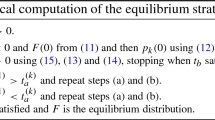Abstract
We introduce the effect of delay in walking from the head of the queue to the service windows in the queueing theory, and obtain the suitable type of queueing system under various conditions. When there are plural service windows, the queueing theory indicates that a fork-type queue, which collects people into a single queue, is more efficient than a parallel-type queue, i.e., queues for each service windows. However, in the walking-distance introduced queueing theory, we find that the parallel-type queue is more efficient when sufficiently many people are waiting in queues, and service time is shorter than walking time. We also consider the situation where there are two kinds of people, whose service time is short and long. The analytical result says that we can decrease people’s waiting time and their stress by setting up queues for each kind of people separately.
Access this chapter
Tax calculation will be finalised at checkout
Purchases are for personal use only
Preview
Unable to display preview. Download preview PDF.
Similar content being viewed by others
References
Erlang, A.K.: The theory of probabilities and telephone conversations. Nyt. Tidsskr. Mat. Ser. B 20, 33–39 (1909)
Kendall, D.G.: Stochastic Processes Occurring in the Theory of Queues and Their Analysis by the Method of the Imbedded Markov Chain. Ann. Math. Statist. 24(3), 338–354 (1953)
Burke, P.J.: The Output of a Queueing System. Operations Research 4(6), 699–704 (1956)
Jackson, J.K.: Networks of waiting lines. Operations Research 5(4), 518–521 (1957)
Little, J.C.D.: A proof for the queueing formula L = λW. Operations Research 9(3), 383–387 (1961)
Kasahara, S.: Towards Queueing Theory for the Internet Design. Technical Report of IEICE 101(649), 25–30 (2002)
Mukherjee, G., Manna, S.S.: Phase transition in a directed traffic flow network. Phys. Rev. E 71, 066108 (2005)
Barabasi, A.-L.: The origin of bursts and heavy tails in human dynamics. Nature 435, 207–211 (2005)
Helbing, D., Treiber, M., Kesting, A.: Understanding interarrival and interdeparture time statistics from interactions in queueing systems. Physica A 363, 62–72 (2006)
Helbing, D., Jiang, R., Treiber, M.: Analytical investigation of oscillations in intersecting flows of pedestrian and vehicle traffic. Phys. Rev. E 72, 046130 (2005)
Chowdhury, D., Santen, L., Schadschneider, A.: Statistical physics of vehicular traffic and some related systems. Phys. Rep. 329, 199–329 (2000)
Helbing, D.: Traffic and related self-driven many-particle systems. Rev. Mod. Phys. 73, 1067–1141 (2001)
Nishinari, K., Kirchner, A., Namazi, A., Schadschneider, A.: Nonmembers: Extended Floor Field CA Model for Evacuation Dynamics. IEICE Transactions on Information and Systems E87-D(3), 726–732 (2004)
Yanagisawa, D., Nishinari, K.: Mean Field Theory for Pedestrian Outflow through an Exit. Phys. Rev. E 76, 061117 (2007)
Bolch, G., Greiner, S., de Meer, H., Trivedi, K.S.: Queueing Networks and Markov Chains. A Wiley-Interscience Publication, U.S.A (1998)
Author information
Authors and Affiliations
Editor information
Rights and permissions
Copyright information
© 2008 Springer-Verlag Berlin Heidelberg
About this paper
Cite this paper
Yanagisawa, D., Tomoeda, A., Kimura, A., Nishinari, K. (2008). Walking-Distance Introduced Queueing Theory. In: Umeo, H., Morishita, S., Nishinari, K., Komatsuzaki, T., Bandini, S. (eds) Cellular Automata. ACRI 2008. Lecture Notes in Computer Science, vol 5191. Springer, Berlin, Heidelberg. https://doi.org/10.1007/978-3-540-79992-4_59
Download citation
DOI: https://doi.org/10.1007/978-3-540-79992-4_59
Publisher Name: Springer, Berlin, Heidelberg
Print ISBN: 978-3-540-79991-7
Online ISBN: 978-3-540-79992-4
eBook Packages: Computer ScienceComputer Science (R0)




